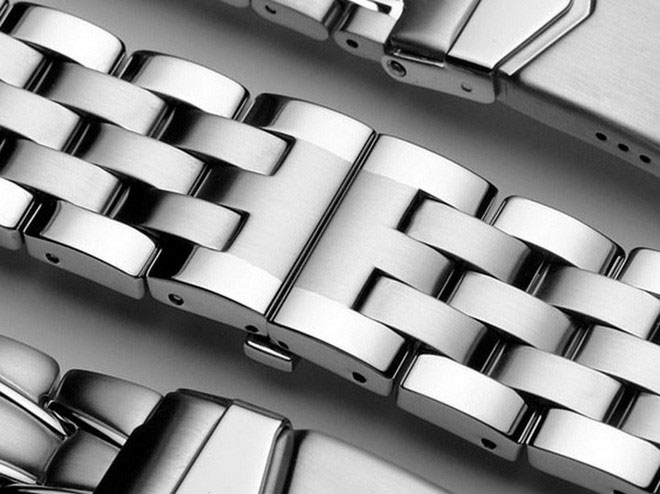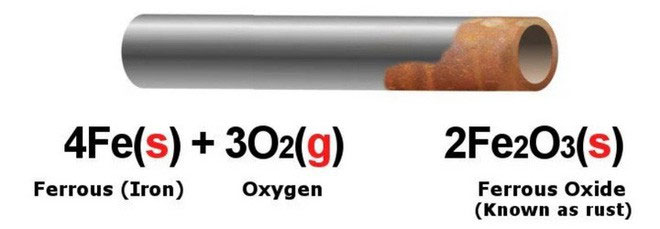Explain the chemical mechanism that makes stainless steel 'anti-rust' against the impact of the environment
A great combination of metal components that make up a strong alloy and can provide excellent rust protection like stainless steel? So what is the secret behind that combination?
The article will provide you with useful information on how people cleverly combine metals together to create stainless steel products, served daily in food, display or setting. next.

Stainless steel is used quite a lot in all aspects of life, such as watch straps.
Stainless steel is supposed to be named so for a very simple reason, they cannot be rusted like normal steel or young steel (low carbon steel). In other words, they are resistant to rust against environmental impacts.
But the question is how do these steels not rust? First of all you need to understand the concept of rust.
What is rust?
Rust is the phenomenon of iron being corroded due to the impact of weather conditions or objective causes. Rust rust will often create a rough, red layer outside the iron core. Rust is merely understood as oxidation of metals. When iron comes into contact with oxygen in the air, metal oxide layers and hydroxides begin to form. Especially in wet, metal environments, in particular iron easily corrode. The result after oxidized iron becomes iron oxide and rust.

Iron combined with oxygen creates rust layers.
Iron corrosion is an electrochemical reaction, so the first patina is usually only thin atomic layers. But if this process lasts, they will create thick, visible layers of rust.
Rust makes iron lose its hardness and inherent durability. Therefore, objects that are rusted often lose quite a bit in volume and are easily damaged when they break. Annual losses due to rust can reach billions of dollars so if you don't prevent this, people can waste a large amount of resources and waste time and effort.
What is steel?
Two or more metals and non-metals can be mixed or combined together to form a mixture of sufficient strength or strength. Mixing to enhance metal properties will create something called an alloy .
And steel is such an alloy. That is why you will find it difficult to find steel in the periodic table of chemical elements.
Iron is one of the most abundant metals on Earth but they are often in pure form and have a very weak structure. Iron atoms are arranged in layers and they can easily slip to other layers even with very small impacts. This makes iron extremely soft and dangerous if used for construction.
Therefore, people have devised ways to combine iron with carbon to create steel alloys. The alloy has a strong bonding structure between carbon atoms, so it is very strong. Since then, steel has become a popular construction material globally.

Steel is used primarily in construction but if not preserved well, it will easily rust due to the environment.
Carbon can make steel stronger and stronger than aluminum, making it hard to crack. However, they still have an undeniable disadvantage, which is their resistance to poor corrosion. In other words, steel can corrode quickly if exposed to high humidity environments. At this point, we will need to combine steel and an element that can prevent oxidation. And chromium is a great choice to prevent corrosion because it is like a "armor plate" that prevents oxygen from contacting the inner iron layer.
So what is stainless steel?
Stainless steel, also known as stainless steel , is not only iron, carbon and chromium alloy. It also contains other metals such as manganese (Mn), some nickel (Ni) and molybdenum (Mo) which are resistant to rust. Although it is a metal, even if it is corroded before the innermost layer of iron, these metals are less harmful to humans.

The housewives' popular stainless steel products are stainless steel cookware.
When surrounded by aluminum, aluminum oxide layers will protect the inner iron layer, avoiding exposure to oxygen, causing oxidation. This is also true for the chromium protection layer outside. Thus, stainless steel is less prone to discoloration and corrosion.
In metallurgy, stainless steel is understood to be a form of iron alloy containing at least 10.5% chromium. They will react with oxygen and form a thin but rather hard (chromium oxide) layer, protecting the inner steel layer. This protective layer is so thin that it cannot be seen with the naked eye. Therefore the stainless steel surface is still shiny despite being subjected to the effects of oxygen molecules in the air everyday.
Although stainless steel does not have as good rigidity as construction steels, it has important features that many other steels do not.
Stainless steel is mostly used to make items, tools must be in contact with water, for example razors, watch straps . In addition, the properties of chromium are polished and easy to clean. so will contribute to increase the aesthetics of objects.
- Steel 3D prints stainless and is more resistant to ordinary steel
- New steel is 62 times more rigid
- Successfully developed stainless steel mesh for water to flow through and keep the oil in place
- Use cigarette filter to prevent rust
- Mysterious iron pillar of 1,600 years old stainless steel
- New materials help Chinese warships
- The largest steel in the world
- Incredible but great inventions
- Video: 8-foot starfish object suspected of alien equipment
- You will be surprised to know that technology today can do this
- 'Armor' for PC
- Two poisonous substances in Chinese heat-keeping bottles kill people very quickly
 'Fine laughs' - Scary and painful torture in ancient times
'Fine laughs' - Scary and painful torture in ancient times The sequence of numbers 142857 of the Egyptian pyramids is known as the strangest number in the world - Why?
The sequence of numbers 142857 of the Egyptian pyramids is known as the strangest number in the world - Why? History of the iron
History of the iron What is alum?
What is alum? How was steel born?
How was steel born?  Invented a wooden knife that is sharper than steel
Invented a wooden knife that is sharper than steel  Stainless steel - why is it called 'stainless steel'?
Stainless steel - why is it called 'stainless steel'?  The US built the world's first solar steel factory
The US built the world's first solar steel factory  Expert team develops self-healing anti-rust coating
Expert team develops self-healing anti-rust coating  Manually label with test screen for melting steel with hydraulic press
Manually label with test screen for melting steel with hydraulic press 